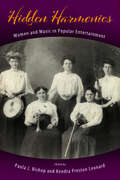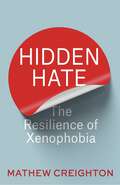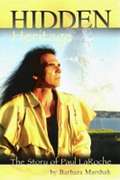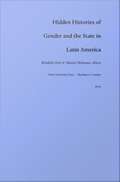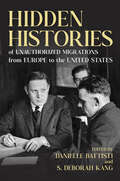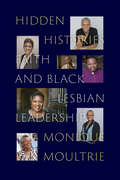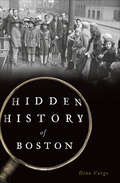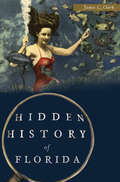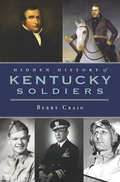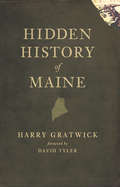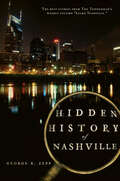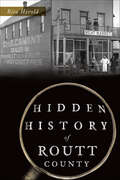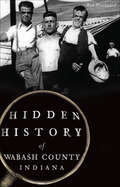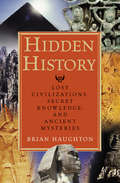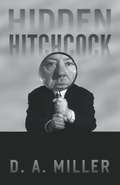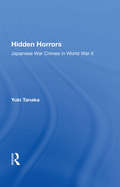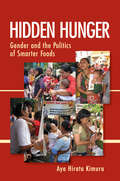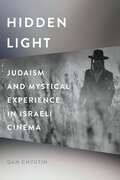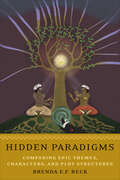- Table View
- List View
Hidden Harmonies: Women and Music in Popular Entertainment (American Made Music Series)
by Paula J. Bishop and Kendra Preston LeonardContributions by Christina Baade, Candace Bailey, Paula J. Bishop, Maribeth Clark, Brittany Greening, Tammy Kernodle, Kendra Preston Leonard, April L. Prince, Travis D. Stimeling, and Kristen M. TurnerFor every star, there are hundreds of less-recognized women who contribute to musical communities, influencing their aesthetics and expanding opportunities available to women. Hidden Harmonies: Women and Music in Popular Entertainment focuses not on those whose names are best known nor most celebrated but on the women who had power in collective or subversive ways hidden from standard histories.Contributors to Hidden Harmonies reexamine primary sources using feminist and queer methodologies as well as critical race theory in order to overcome previous, biased readings. The scholarship that results from such reexaminations explores topics from songwriters to the music of the civil rights movement and from whistling schools to musical influencers. These wide-ranging essays create a diverse and novel view of women's contribution to music and its production. With intelligence and care, Hidden Harmonies uncovers the fascinating figures behind decades of popular music.
Hidden Hate: The Resilience of Xenophobia
by Mathew CreightonOpposition to immigration has fueled a spate of populist movements in the United States and Europe. The potency of xenophobic politics is often explained in terms of factors such as economic insecurity, material competition, group identity, cultural conflicts, and social changes. These explanations have proven to be inadequate, particularly in often affluent and pluralistic contexts with relatively low levels of unemployment and poverty. How can these seemingly tolerant societies harbor intense antipathy toward migrants?Mathew Creighton develops a new model for understanding xenophobia by shining a light on the layers of intolerance concealed beneath the surface. Drawing on rich empirical evidence from innovative survey experiments conducted in the United States, the United Kingdom, Ireland, Norway, and the Netherlands, he argues that prejudice is often present but intentionally and strategically hidden. What can change, however, are the norms that govern the social acceptability of xenophobia. When the public expression of previously impermissible beliefs is pursued by politicians and society more broadly, the stigma of open intolerance lifts to reveal the true face of this once-masked xenophobia. Creighton challenges the assumption that overt anti-immigrant sentiment is mostly attributable to economic or social crises, showing that this narrative overlooks a substantial and largely stable reservoir of intolerance.Deeply researched, comparative, and generative, Hidden Hate provides timely and vital insight into the persistence of xenophobia.
Hidden Heads of Households: Child Labor In Urban Northeast Brazil (Teaching Culture: Utp Ethnographies For The Classroom Ser.)
by Mary Lorena KennyIn the cities of Northeast Brazil where 50 per cent of the population lives in poverty, children play a key role in the local economy—in their households, in formal jobs, and in the thriving informal sector (washing cars, shining shoes, scavenging for recyclables, etc.). Why children migrate to the city, how they negotiate their existence, and why they stay are just some of the questions addressed in this fascinating study. Mary Kenny spent close to 15 years in the urban areas of Northeast Brazil talking with and interviewing children. She even gave them disposable cameras to document their daily lives (many of the photographs they took are included). Rather than lament a lost childhood, or try to save these children, Kenny explores some of the complex conditions under which these children work and live. She illustrates how unrelenting scarcity shapes family and, by extension, children's options, decisions, and worldviews. The issues raised in this book are of critical importance. There are no easy answers, but listening to how these children define themselves and their circumstances is an important step towards understanding and ultimately solving economic and social inequality.
Hidden Heretics: Jewish Doubt in the Digital Age (Princeton Studies in Culture and Technology #27)
by Ayala FaderA revealing look at Jewish men and women who secretly explore the outside world, in person and online, while remaining in their ultra-Orthodox religious communities What would you do if you questioned your religious faith, but revealing that would cause you to lose your family and the only way of life you had ever known? Hidden Heretics tells the fascinating, often heart-wrenching stories of married ultra-Orthodox Jewish men and women in twenty-first-century New York who lead “double lives” in order to protect those they love. While they no longer believe that God gave the Torah to Jews at Mount Sinai, these hidden heretics continue to live in their families and religious communities, even as they surreptitiously break Jewish commandments and explore forbidden secular worlds in person and online. Drawing on five years of fieldwork with those living double lives and the rabbis, life coaches, and religious therapists who minister to, advise, and sometimes excommunicate them, Ayala Fader investigates religious doubt and social change in the digital age.The internet, which some ultra-Orthodox rabbis call more threatening than the Holocaust, offers new possibilities for the age-old problem of religious uncertainty. Fader shows how digital media has become a lightning rod for contemporary struggles over authority and truth. She reveals the stresses and strains that hidden heretics experience, including the difficulties their choices pose for their wives, husbands, children, and, sometimes, lovers. In following those living double lives, who range from the religiously observant but open-minded on one end to atheists on the other, Fader delves into universal quandaries of faith and skepticism, the ways digital media can change us, and family frictions that arise when a person radically transforms who they are and what they believe.In stories of conflicts between faith and self-fulfillment, Hidden Heretics explores the moral compromises and divided loyalties of individuals facing life-altering crossroads.
Hidden Heritage: The Story of Paul Laroche
by Barbara MarshakA spiritual legacy of one man's ordinary Minnesota lifestyle, suddenly fused with a rich, Lakota heritage that enabled him to cross boundaries far beyond his own expectations. Imagine waking up one day to discover you belong to a completely different culture. Paul Summers, a 38-year-old father of two, has just discovered that his birth mother was a member of the Lakota tribe from South Dakota. Drained physically, emotionally, and financially following his attempts to pursue a career in music, Paul hits rock bottom.
Hidden Heroes: America's Military Caregivers
by Terri Tanielian Rajeev Ramchand Michael P. Fisher Christine Anne Vaughan Thomas E. Trail Caroline Epley Phoenix Voorhies Michael William Robbins Eric Robinson Bonnie Ghosh-DastidarLittle has been reported about "military caregivers"--the population of those who care for wounded, ill, and injured military personnel and veterans. This report summarizes the results of a study designed to describe the magnitude of military caregiving in the United States today, as well as to identify gaps in the array of programs, policies, and initiatives designed to support military caregivers.
Hidden Histories of Gender and the State in Latin America
by Elizabeth Dore Maxine MolyneuxThis collection examines the mutually influential interactions of gender and the state in Latin America from the late colonial period to the end of the twentieth century. Locating watershed moments in the processes of gender construction by the organized power of the ruling classes and in the processes by which gender has conditioned state-making, Hidden Histories of Gender and the State in Latin America remedies the lack of such considerations in previous studies of state formation. Along these lines, the book begins with two theoretical chapters by the editors, Elizabeth Dore and Maxine Molyneux. Dore opens by arguing against the prevailing view that the nineteenth century was marked by a gradual emancipation of women, while Molyneux considers how various Latin American state forms--liberal, corporatist, socialist, neoliberal--have more recently sought to incorporate women into their projects of social reform and modernization. These essays are followed by twelve case studies that examine how states have contributed to the normalization of male and female roles and relations. Covering an impressive breadth not only of historical time but also of geographical scope, this volume moves from Brazil to Costa Rica, from Mexico to Chile, traversing many countries in between. Contributors explore such topics as civic ritual in Bolivia, rape in war-torn Colombia, and the legal construction of patriarchy in Argentina. They examine the public regulation of domestic life, feminist lobby groups, class compromise, female slaves, and women in rural households--distinct, salient aspects of the state-gender relationship in specific countries at specific historical junctures. By providing a richly descriptive and theoretically grounded account of the interaction between state and gender politics in Latin America, this volume contributes to an important conversation between feminists interested in the state and political scientists interested in gender. It will be valuable to such disciplines as history, sociology, international comparative studies, and Latin American studies. Contributors. Mara Eugenia Chaves, Elizabeth Dore, Rebecca Earle, Jo Fisher, Laura Gotkowitz, Donna J. Guy, Fiona Macaulay, Maxine Molyneux, Eugenia Rodriguez, Karin Alejandra Rosemblatt, Ann Varley, Mary Kay Vaughan
Hidden Histories of Unauthorized Migrations from Europe to the United States (Studies of World Migrations)
by S. Deborah Kang Mary Patrice Erdmans Danielle Battisti Joanna Wojdon Ashley Johnson Bavery Carly Goodman Torsten Feys Randa Tawil Polina Ermoshkina E. Kyle RomeroOften depicted as the nation’s iconic legal immigrant, unauthorized European migrants are often overlooked by scholars, policymakers, and the media. This volume tells the stories of European migrants who adopted irregular migration strategies to enter and remain in the United States throughout the twentieth century. Contributors explore facets of this history with essays on migration patterns from Russia, Italy, Ireland, the Ottoman Empire, and Poland. They also offer important arguments about the treatment of unauthorized European migrants by states and societies on both sides of the Atlantic and how the reception of undocumented immigrants has been and continues to be impacted by the dynamics of racial, class, and gender constructions in the United States and abroad. As the contributors show, the reception accorded unauthorized European migrants frequently obscured and even normalized their irregular migration strategies, easing their access to American citizenship. Revealing and insightful, Hidden Histories of Unauthorized Migrations from Europe to the United States sheds new light our intertwined notions of race, legality, and immigration. Contributors: Danielle Battisti, Ashley Johnson Bavery, Mary Patrice Erdmans, Polina Ermoshkina, Torsten Feys, Carly Goodman, S. Deborah Kang, E. Kyle Romero, Randa Tawil, and Joanna Wojdon
Hidden Histories: Faith and Black Lesbian Leadership
by Monique MoultrieIn Hidden Histories, Monique Moultrie collects oral histories of Black lesbian religious leaders in the United States to show how their authenticity, social justice awareness, spirituality, and collaborative leadership make them models of womanist ethical leadership. By examining their life histories, Moultrie frames queer storytelling as an ethical act of resistance to the racism, sexism, and heterosexism these women experience. She outlines these women’s collaborative, intergenerational, and leadership styles, and their concerns for the greater good and holistic well-being of humanity and the earth. She also demonstrates how their ethos of social justice activism extends beyond LGBTQ and racialized communities and provides other models of religious and community leadership. Addressing the invisibility of Black lesbian religious leaders in scholarship and public discourse, Moultrie revises modern understandings of how race, gender, and sexual identities interact with religious practice and organization in the twenty-first century.
Hidden History
by Donald JeffriesThe US government has spent half the time covering up conspiracies as it has spent helping the American people. In Hidden History, you will see the amount of effort over the past fifty years that our government has dedicated to lying and covering up the truth to the world.Starting with the assassination of President John F. Kennedy, Don Jeffries chronicles a wide variety of issues that have plagued our country's history. Whether it's the assassinations of MLK and RFK, Iran-Contra, the Oklahoma City bombing, TWA Flight 800, voting fraud, or 9/11, every major disaster or war that we've witnessed has somehow been distorted by those who are supposed to be protecting us.Jeffries also delves into extensive research on the death of John F. Kennedy Jr., and you'll be shocked by what he finds out.So whether you've only heard bits and pieces of these stories or have read several books on the topics, Hidden History is the book that belongs in every conspiracy theorist's library, as the information included in this encyclopedia has never been collected together in any other published work available. So sit down, strap in, and get ready to be shocked and awed by how much has been hidden from you by our government over the past fifty years.
Hidden History of Asheville (Hidden History)
by Zoe RhineThe milestones of Asheville's long history are well known to locals, but so many interesting stories are all but forgotten. Thankfully, the staff and volunteers of the North Carolina Room at Pack Memorial Library have unearthed the best of those hidden tales. Meet daredevil aviatrix Uva Shipman and Tempie Avery, who went from slavery to respected nurse and citizen. Learn the poignant tale behind the sad death of former mayor Gallatin Roberts and uncover the parts of old Asheville lost to the wrecking ball. These and many more historic episodes come to life in this collection compiled by North Carolina Room librarian Zoe Rhine.
Hidden History of Boston: History Through Architecture (Hidden History)
by Dina VargoQuirky and little-known true stories of one of America&’s most historic cities. Boston may play a big role in American history textbooks, but it also has quite a bit of forgotten past. For example, during the colonial era, riotous mobs celebrated their hatred of the pope in an annual celebration called Pope&’s Night. In 1659, Christmas was made illegal, a ban by the Puritans that remained in effect for twenty-two years. William Monroe Trotter published the Boston Guardian, an independent African American newspaper, and was a beacon of civil rights activism at the turn of the century. And in more recent times, a centuries-long turf war played out on the streets of quiet Chinatown, ending in the massacre of five men in a back alley in 1991. Author and historian Dina Vargo shines a light into the cobwebbed corners of Boston&’s hidden history in this riveting read, complete with illustrations.
Hidden History of Florida (Hidden History)
by James C. ClarkA Florida historian uncovers strange but true tales of The Sunshine State from the 16th century arrival of Spanish ships to the antics of modern politics. From Key West to the Redneck Riviera, Florida has a history as colorful as its landscape and as diverse as its residents. But beneath the famous legends of Florida&’s storied past are intriguing tales that don&’t appear in the popular guides or history books. In Hidden History of Florida, author James Clark shines a light on some of the most fascinating untold stories of this unique Southern State. Here you will learn about then heartbroken senator who entered a mental institution over unrequited love for an heiress; the thousands of British pilots who trained in flight schools across the state; and the dark, true story of Pocahontas—and how it is linked with America&’s "first barbecue."
Hidden History of Kentucky Soldiers (Hidden History Ser.)
by Berry CraigA look at the lesser-known heroics of Kentucky soldiers, from the French and Indian War to World War II. Daniel Boone is celebrated as a Kentucky frontiersman, but what about his service in the French and Indian War? Custer&’s Last Stand in the Great Sioux War is legendary, but few remember Custer&’s &“next-to-last-stand&” in Elizabethtown, where he was sent to suppress the Ku Klux Klan and hunt down moonshiners just before heading to the Montana Territory and into history. Join Kentucky historian Berry Craig as he unearths the forgotten heroics of Kentucky soldiers, beginning with the French and Indian War and ending with World War II. Featuring tales of warriors from a diverse range of backgrounds, Hidden History of Kentucky Soldiers honors generations of Kentuckians who put their lives on the line for their country.
Hidden History of Maine (Hidden History)
by Harry GratwickDiscover 400 years of New England history you won&’t find in guidebooks in this collection of true stories and colorful characters from The Pine Tree State. Maine wouldn&’t be the magical place it is today without the contributions of little-known individuals whose inspiring and adventuresome lives make up the story of Maine's "hidden history." Journalist and Maine historian Harry Gratwick presents vividly detailed portraits of these Mainers, from the controversial missionary Sebastien Rale to Woolwich native William Phips, whose seafaring attacks against French Canada earned him the first governorship of the Massachusetts Bay Colony. Gratwick also profiles inventors such as Robert Benjamin Lewis, an African American from Gardiner who patented a hair growth product in the 1830s, and Margaret Knight, a York native who defied nineteenth-century sexism to earn the nickname "the female Edison." From soprano Lillian Nordica, who left Farmington to become the most glamorous American opera singer of her day, to slugger George "Piano Legs" Gore, the only Mainer to ever win a Major League Baseball batting championship, Hidden History of Maine reveals the men and women who made history without making it into history books.
Hidden History of Nashville: The Best Stories From The Tennessean's Weekly Column "Learn Nashville" (Hidden History)
by George R ZeppThis collection uncovers the fascinating past of Tennessee&’s legendary Music City from true tall tales to larger than life characters and much more. Perched on the banks of the Cumberland River, Nashville is best known for its role in the civil rights movement, world-class education and, of course, country music. In this unique collection of columns written for The Tennessean, journalist and longtime Tennessee native George Zepp illuminates a less familiar side of the city&’s history. Here, readers will learn the secrets of Timothy Demonbreun, one of the city's first residents, who lived with his family in a cliff-top cave; Cortelia Clark, the blind bluesman who continued to perform on street corners after winning a Grammy award; and Nashville's own Cinderella story, which involved legendary radio personality Edgar Bergen and his ventriloquist protegee. Based on questions from readers across the nation, these little-known tales abound with Music City mystery and charm.
Hidden History of Routt County (Hidden History)
by Rita HeroldSettling Routt County was never easy or safe. Fugitives used the undeveloped landscape as an "outlaw trail" to evade authorities. The inexorable Harry Tracy managed three jailbreaks before being killed by a posse. Conversely, many of the first families left entrepreneurial legacies. Widowed Alice Bartz sold the family homestead to start the Bartz Hotel in her Steamboat Springs' bakery and house, serving three meals a day to locals and guests. Others families, like the Nays and the Laughlins, were able to cut hay and raise enough livestock to pass the land down to future generations. Native author Rita Herold preserves oral histories and nearly forgotten episodes of the county's past.
Hidden History of Wabash County, Indiana (Hidden History)
by Ron WoodwardTake the road less traveled through Wabash County's forgotten stories and overlooked characters. Bob Printy may have run off to join the circus, but Jocko the monkey decided to make Wabash his home after he escaped a traveling carnival. Discover the story of Chief LeGros and learn what life was like in nineteenth-century Wabash County. Spend some time with Tommy R. Miller, who sacrificed his life caring for fellow servicemen in Vietnam. Author Ron Woodward shares the compelling, little-known history of this Indiana county.
Hidden History: An Exposé of Modern Crimes, Conspiracies, and Cover-Ups in American Politics
by Roger Stone Donald JeffriesThe US government has spent as much time covering up conspiracies as it has helping the American people. In Hidden History, you will see the amount of effort that our government has dedicated over the past fifty years to lying and covering up the truth to the world.Starting with the assassination of President John F. Kennedy, Don Jeffries chronicles a wide variety of issues that have plagued our country's history. Whether it is the assassinations of MLK and RFK, Iran-Contra, the Oklahoma City bombing, TWA Flight 800, voting fraud, or 9/11, every major disaster or war that we've sitnessed has somehow been distorted by those who are supposed to be protecting us. Jeffries also delves into extensive research on the death of John F. Kennedy, Jr. - and what he finds will shock you.So whether you've only heard bits and pieces of these stories or you've read several books on the topics, Hidden History is the book that belongs in every conspiracy theorist's library, as the information included here has never been collected together in any other published work available. So sit down, strap in, and get ready to be shocked and awed by how much has been hidden by our government over the past fifty years. Updated for 2016, this version features a new introduction by political insider Roger Stone.
Hidden History: Lost Civilizations, Secret Knowledge, and Ancient Mysteries
by Brian HaughtonAn archaeologist explores history&’s most fascinating enigmas, from the ancient Druids to the mysteries of the Mayan calendar and the lost city of Atlantis. Across thousands of years of history, so-called lost civilizations still speak to us through their artifacts and architecture. In Hidden History, archaeologist Brian Haughton fills the gap between archaeology and alternative history using the latest available data and a common sense, open-minded approach. Divided into three sections, this expertly researched volume shares the secrets of Mysterious Places, Unexplained Artifacts, and Enigmatic People. Haughton introduces readers to the greatest mysteries of the ancient world, from the labyrinthine palace of Knossos on Crete to the pyramids of Egypt, the remote jungle temples of Peru, and the megalithic mystery of Stonehenge. But he also goes further to explore historical puzzles like the Coso Artifact, the possibility of ancient flight, and the Voynich Manuscript, as well as mysterious peoples from the Magi and the Druids to the Knights Templar and the Green Children. With more than 50 photographs and illustrations, this is the ideal reference work for those interested in the archaeology of these great enigmas.
Hidden Hitchcock
by D. A. MillerNo filmmaker has more successfully courted mass-audience understanding than Alfred Hitchcock, and none has been studied more intensively by scholars. In Hidden Hitchcock, D. A. Miller does what seems impossible: he discovers what has remained unseen in Hitchcock's movies, a secret style that imbues his films with a radical duplicity. Focusing on three films--Strangers on a Train, Rope, and The Wrong Man--Miller shows how Hitchcock anticipates, even demands a "Too-Close Viewer." Dwelling within us all and vigilant even when everything appears to be in good order, this Too-Close Viewer attempts to see more than the director points out, to expand the space of the film and the duration of the viewing experience. And, thanks to Hidden Hitchcock, that obsessive attention is rewarded. In Hitchcock's visual puns, his so-called continuity errors, and his hidden appearances (not to be confused with his cameos), Miller finds wellsprings of enigma. Hidden Hitchcock is a revelatory work that not only shows how little we know this best known of filmmakers, but also how near such too-close viewing comes to cinephilic madness.
Hidden Horrors: Japanese War Crimes In World War Ii (Asian Voices Ser.)
by Yuki TanakaThis book documents for the first time previously hidden Japanese atrocities in World War II, including cannibalism; the slaughter and starvation of prisoners of war; the rape, enforced prostitution, and murder of noncombatants; and biological warfare experiments. The author describes how desperate Japanese soldiers consumed the flesh of their own comrades killed in fighting as well as that of Australians, Pakistanis, and Indians. Another chapter traces the fate of 65 shipwrecked Australian nurses and British soldiers who were shot or stabbed to death by Japanese soldiers. Thirty-two other nurses, who landed on another island, were captured and sent to Sumatra to become “comfort women‗prostitutes for Japanese soldiers. Tanaka recounts how thousands of Australian and British POWs died in the infamous Sandakan camp in the Borneo jungle in 1945. Those who survived were forced to endure a tortuous 160-mile march on which anyone who dropped out of line was immediately shot. Only six escapees lived to tell the tale. Based on exhaustive research in previously closed archives, this book represents a landmark analysis of Japanese war crimes. The author explores individual atrocities in their broader social, psychological, and institutional milieu and places Japanese behavior during the war in the broader context of the dehumanization of men at war—without denying individual and national responsibility.
Hidden Hunger: Gender and the Politics of Smarter Foods
by Aya Hirata KimuraFor decades, NGOs targeting world hunger focused on ensuring that adequate quantities of food were being sent to those in need. In the 1990s, the international food policy community turned its focus to the "hidden hunger" of micronutrient deficiencies, a problem that resulted in two scientific solutions: fortification, the addition of nutrients to processed foods, and biofortification, the modification of crops to produce more nutritious yields. This hidden hunger was presented as a scientific problem to be solved by "experts" and scientifically engineered smart foods rather than through local knowledge, which was deemed unscientific and, hence, irrelevant. In Hidden Hunger, Aya Hirata Kimura explores this recent emphasis on micronutrients and smart foods within the international development community and, in particular, how the voices of women were silenced despite their expertise in food purchasing and preparation. Kimura grounds her analysis in case studies of attempts to enrich and market three basic foods-rice, wheat flour, and baby food-in Indonesia. She shows the power of nutritionism and how its technical focus enhanced the power of corporations as a government partner while restricting public participation in the making of policy for public health and food. She also analyzes the role of advertising to promote fortified foodstuffs and traces the history of Golden Rice, a crop genetically engineered to alleviate vitamin A deficiencies. Situating the recent turn to smart food in Indonesia and elsewhere as part of a long history of technical attempts to solve the Third World food problem, Kimura deftly analyzes the intersection of scientific expertise, market forces, and gendered knowledge to illuminate how hidden hunger ultimately defined women as victims rather than as active agents.
Hidden Light: Judaism and Mystical Experience in Israeli Cinema (Contemporary Approaches to Film and Media Series)
by Dan ChyutinOver the past several decades, the prevailing attitude toward Judaism in Israeli society has undergone a meaningful shift; where the national ethos had once deemed Judaic traditions a vestige of an arcane past incompatible with the culture of a modern state, there is now greater acceptance of these traditions by a sizeable part of Israeli society. Author Dan Chyutin reveals this trend through a parallel shift toward acceptance and celebration of Judaic identity and lifestyle in modern Israeli cinema. Hidden Light explores the Judaic turn in contemporary Israeli filmmaking for what it can tell us about Israel’s cultural landscape, as well as about the cinematic medium in general. Chyutin points to the ambivalence of films which incorporate Judaism into Israel’s secular ethos; concurrently, he foregrounds the films' attempt to overcome this ambivalence through reference to and activation of experiences of transcendence and unity, made popular by New Age–inflected understandings of Jewish mystical thought. By virtue of this exploration, Judaic-themed Israeli cinema emerges as a crucial example of how film’s particular form of "magic" may be exploited for the purpose of affecting mystical states in the audience.
Hidden Paradigms: Comparing Epic Themes, Characters, and Plot Structures
by Brenda E.F. BeckUnderstanding an epic story’s key belief patterns can reveal community-level values, the nature of familial bonds, and how divine and human concerns jockey for power and influence. These foundational motifs remain understudied as they relate to South Asian folk legends, but are nonetheless crucial in shaping the values exemplified by such stories’ central heroes and heroines. In Hidden Paradigms, anthropologist Brenda E.F. Beck describes The Legend of Ponnivala, an oral epic from rural South India. Recorded in 1965, this story was sung to a group of village enthusiasts by a respected pair of local bards. This grand legend took more than thirty-eight hours to complete over eighteen nights. Bringing this unique example of Tamil culture to the attention of an international audience, Beck compares this virtually unknown South Indian epic to five other culturally significant works – the Ojibwa Nanabush cycle, the Mahabharata, an Icelandic Saga, the Bible, and the Epic of Gilgamesh – establishing this foundational Tamil story as one that engages with the same universal human struggles and themes present throughout the world. Copiously illustrated, Hidden Paradigms provides a fresh example of the power of comparative thinking, offering a humanistic complement to scientific reasoning.
